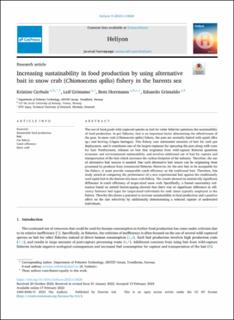| dc.contributor.author | Cerbule, Kristine | |
| dc.contributor.author | Grimsmo, Leif | |
| dc.contributor.author | Herrmann, Bent | |
| dc.contributor.author | Grimaldo, Eduardo | |
| dc.date.accessioned | 2023-08-14T11:37:46Z | |
| dc.date.available | 2023-08-14T11:37:46Z | |
| dc.date.created | 2023-06-14T12:48:03Z | |
| dc.date.issued | 2023 | |
| dc.identifier.citation | Heliyon. 2023, 9 (3), . | en_US |
| dc.identifier.issn | 2405-8440 | |
| dc.identifier.uri | https://hdl.handle.net/11250/3083847 | |
| dc.description.abstract | The use of food grade wild-captured species as bait for other fisheries questions the sustainability of food production. In pot fisheries, bait is an important factor determining the effectiveness of the gear. In snow crab (Chionoecetes opilio) fishery, the pots are normally baited with squid (Illex sp.) and herring (Clupea harengus). This fishery uses substantial amounts of bait for each pot deployment, and it constitutes one of the largest expenses for operating the pots along with costs for fuel. Furthermore, reliance on bait that originates from wild-capture fisheries questions economic and environmental sustainability, and involves additional use of fuel for capture and transportation of the bait which increases the carbon footprint of the industry. Therefore, the use of alternative bait sources is needed. One such alternative bait source can be originating from processed by-products from commercial fisheries. However, for the new bait to be acceptable for the fishery, it must provide comparable catch efficiency as the traditional bait. Therefore, this study aimed at comparing the performance of a new experimental bait against the traditionally used squid bait in the Barents Sea snow crab fishery. The results showed no statistically significant difference in catch efficiency of target-sized snow crab. Specifically, a formal uncertainty estimation based on nested bootstrapping showed that there was no significant difference in efficiency between bait types for target-sized individuals for soak times typically employed in the fishery. Thereby this shows a potential to increase sustainability in food production and a positive effect on the size selectivity by additionally demonstrating a reduced capture of undersized individuals. | en_US |
| dc.language.iso | eng | en_US |
| dc.publisher | Cell Press | en_US |
| dc.rights | Navngivelse 4.0 Internasjonal | * |
| dc.rights.uri | http://creativecommons.org/licenses/by/4.0/deed.no | * |
| dc.subject | Sustainable food production | en_US |
| dc.subject | Bait | en_US |
| dc.subject | Pot fishery | en_US |
| dc.subject | Catch efficiency | en_US |
| dc.subject | Snow crab | en_US |
| dc.title | Increasing sustainability in food production by using alternative bait in snow crab (Chionoecetes opilio) fishery in the barents sea | en_US |
| dc.title.alternative | Increasing sustainability in food production by using alternative bait in snow crab (Chionoecetes opilio) fishery in the barents sea | en_US |
| dc.type | Journal article | en_US |
| dc.type | Peer reviewed | en_US |
| dc.description.version | publishedVersion | en_US |
| dc.rights.holder | © 2023 The Author(s). Published by Elsevier Ltd. This is an open access article under the CC BY license (http://creativecommons.org/licenses/by/4.0/). | en_US |
| dc.source.pagenumber | 0 | en_US |
| dc.source.volume | 9 | en_US |
| dc.source.journal | Heliyon | en_US |
| dc.source.issue | 3 | en_US |
| dc.identifier.doi | 10.1016/j.heliyon.2023.e13820 | |
| dc.identifier.cristin | 2154438 | |
| cristin.ispublished | true | |
| cristin.fulltext | original | |
| cristin.qualitycode | 1 | |

